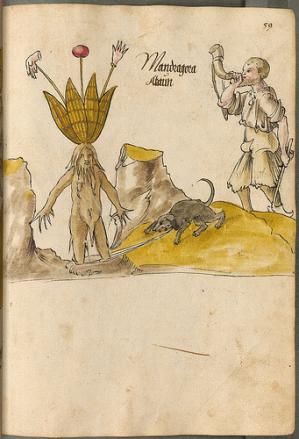Herbalism, the traditional medicinal practice which uses plants, fungi, and extracts to treat illnesses and injury, dates back at least 5,300 years (and is no doubt much older). During the Middle Ages and well into the Renaissance, herbalism was the cutting edge of medicine in Europe and elsewhere (even while the seeds of modern medicine were taking root in the Middle East).
illnesses and injury, dates back at least 5,300 years (and is no doubt much older). During the Middle Ages and well into the Renaissance, herbalism was the cutting edge of medicine in Europe and elsewhere (even while the seeds of modern medicine were taking root in the Middle East).
incorporate elements from folklore (the crossbow is from an age-old
legend, for instance), witchcraft and alchemy (the traditional
anthropomorphic Mandragora* – mandrake – and zoomorphic root forms) and the often stylised appearance of the plants suggest the manuscript artist may have been copying from earlier works.
Pictured here is an example of the anthropomorphized mandrake. The mandrake, of the plant genus Mandragora, belongs to the nightshades family and, according to wikipedia, “contains deliriant hallucinogenic tropane alkaloids such as hyoscyamine.” Mandrake roots, of course, have “long been used in magic rituals, today also in neopagan religions such as Wicca and Germanic revivalism religions such as Odinism.”
